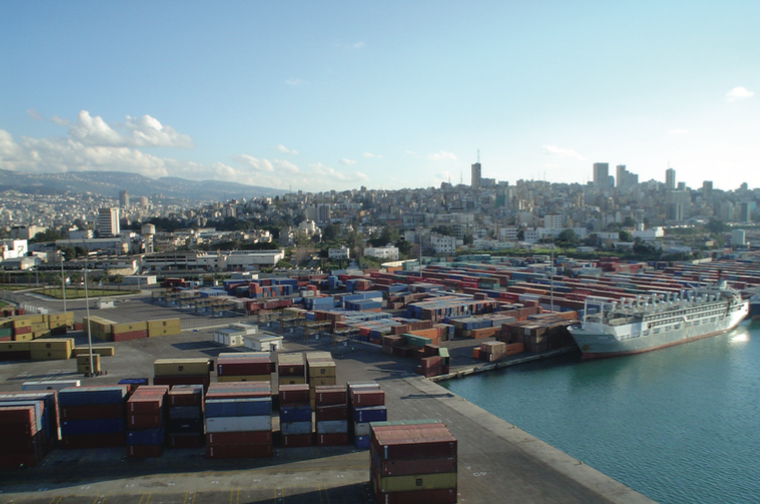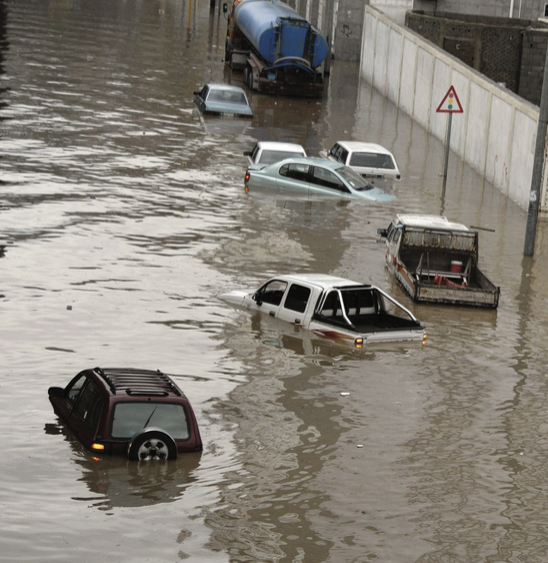| The Beirut Container Terminal, the center of Lebanese maritime trade, located in the Port of Beirut has an illustrious history to live up to. As the motto of the port reads, it is “An Ancient Port for the Future” and the figures for last year certainly live up to it. In 2007, port revenues reached $114 million, up $32 million from the previous year, and custom revenues achieved $736 million, an increase of $118 million. The economic buoyancy of the terminal has clearly not followed that of a seasick Lebanon. This is apparent in the fact that it was in 2005 that the Beirut Container Terminal began its rapid growth. Even the 2006 war could not keep the terminal at bay. Although during the war the port was closed for two months, within 24 hours of re-opening all the major shipping lines were back and queuing three to four days to get back into the port, according to Elie Zakhour, president of the International Chamber of Navigation. |
It was June 2005 that the Beirut Container Terminal Consortium (BCTC) and the Port Authority (PA) announced that, for the first time in the history of the port, the container terminal would begin to handle transshipment vessels. Transshipment being the process, in which a large mother vessel comes into the container terminal, unloads its containers and then these containers are loaded on to other smaller ships for distribution to other regional ports. The Mediterranean Shipping Company (MSC) — “the second biggest shipping company in the world,” according to Muhammad Fakhreddine, vice president of MSC Lebanon — began a transshipment line that directly connected Singapore to Beirut and the Lebanese capital to Antwerp (Belgium). MSC entered into an agreement with BCTC to transship 250,000 TEUs (20-foot equivalent units: a container 20ft long and 8ft wide) per year through the terminal. Soon after MSC signed a transshipment agreement with the port things got even better, when in February 2006 CMA-CGM, also one of the biggest shipping companies in the world, began to use the port for transshipment and signed a contract with BCTC to handle 100,000 TEUs per year.
The success in attracting these two globally operative shipping companies to the container terminal has meant that the port is running at almost full capacity, thus delaying local shipment. Fouad Bawarshi, the vice president of local shipping line Gezairi, told Executive that toward the end of 2007 there was severe congestion at the port and thus the Port Authority had to open two of the old quay terminals. Joseph Farhat, the PA’s study manager, informed Executive that “currently we have 947,000 TEUs and the limit is 1.2 million using the old area. However this area is not fit for use, so we need to have a new quay with new equipment, such as gantry cranes to lift the containers.”
Expanding horizons
The rapid growth in the number of TEUs coming through Beirut’s port has been articulated by the fact that Quay 16, which only became operational in 2005 at the cost of $150 million, has already reached full capacity. Farhat told Executive that when the economic study for the new Quay 16 was carried out in 1997, it concluded that by 2010 the container terminal could reach 500,000 TEUs. “All the studies said that we would not get a transshipment line to the terminal, but we got it!” Due to the introduction of transshipment the target of half a million TEUs came four years early, in 2006. As a result, expansion of the Quay 16 is on the way. “We plan to extend Quay 16 to the east by 170 meters to be completed in two year’s time. This extension will give us 130 meters of extra space and allow roughly an extra 200,000 TEUs a year. The cost of this extension will be around $55 million,” Farhat explained.
Despite this, shipping line owners want more and have become frustrated by the increasing traffic at the port. Elie Zakhour, president of the International Chamber of Navigation and managing director of Uniship, told Executive that the planned 170 meter expansion is insufficient. He pointed out that two other transshipment companies, which he was not allowed to name, were interested in coming to the port but were unable to do so because of a lack of capacity. “The PA has the possibility to extend the port up to Beirut River and double the length of Quay 16, with a 600 meter extension. Unfortunately, due to other situations the government has agreed to extend this quay by only 170 meters.”
Although many shipping lines have been left frustrated by the decision to only extend Quay 16 by 170 meters, the Port Authority is defending their decision, as it is they who will be left with the bill if the transshipment companies leave. Adding to this argument, Farhat explained that, “if we extended as far as the Beirut River we don’t know how much it will cost as there is loose material 40 meters down, near the river.” Ammar Kanaan, chairman of the BCTC, however, agrees with the government’s decision. “The 170 meters was needed to respond to the immediate requirements. There was a serious [business] risk of building an additional 600 meters and not having anyone coming to use it. I think that the way forward should be to expand to the 600 meters and maybe more but to do that with a commitment from the private sector to use this capacity.” However, as Kanaan admitted, in the current political environment getting commitments for the future from these private companies maybe expecting too much. There is a pronounced risk that the current success may only be short-term as Kanaan explained, “The transshipment business is very unfaithful and un-loyal. Unlike the local traffic that is always going to be here, transshipment can easily go away.”
Making it alone
So how did the container terminal achieve the feat of convincing two of the world’s biggest shipping lines to set up regional hubs for transshipment in what is perceived of as an extremely volatile area? Everyone agrees that luck was a major factor. The container terminal acts as a great hub because of its geographical location and the 15.5 meter draft of Quay 16. The draft is especially important because it means that the large mother vessels of the transshipment companies, which have a length of 335 meters and can carry 9,000 TEUs at a time, could use the port. The depth of the draft has really set Beirut’s container terminal apart from its regional competitors and made the it attractive to large shipping companies, MSC’s Muhammad Fakhreddine explained. Added to this, Fakhreddine relayed to Executive the fact that because of the weather conditions in Lebanon, the port can be open 24 hours a day, 365 days of the year, which is also very attractive. Luck also came in the form of incompetence from competitors, Kanaan explained. “When MSC first started working with us, as a transshipment hub, it was because they had problems in Greece. [They] were looking for a quick alternative and we were efficient, had infrastructure and were available.”
The government must also take credit for utilizing the inherent benefits of the port in building a modern deep water terminal and setting up a public private partnership with a US-British-Lebanese consortium to create the BCTC. The success of the BCTC has been an important element in attracting transshipment to Lebanon, specifically because of their efficient operations. Kanaan outlined the way BCTC attracted major transshipment to the Port. “A mother vessel has a charter of $80,000 per day, so when BCTC saves them half a day in terms of productivity I am saving them $40,000. And our rates are very low and among the cheapest in the world. So when you’re saving $100,000 per vessel, you will come to Beirut. Your insurance is no doubt up by $20,000 but you are saving still $80,000 [a day].” Everyone seems to agree that the low rates have been essential in attracting companies such as MSC, except MSC itself. “BCTC made an offer to MSC, we gave a counter offer and reached an agreement. It is not the real issue if the Port of Beirut is less or more than other ports,” said Fakhreddine. However, he does agree that the efficiency attained and maintained by BCTC and the PA has made the port attractive to companies such as his.
Achieving this efficiency has not been a painless process. Automation has been a major way in which the BCTC has achieved gains in efficiency and a tighter control of its income streams. But this has not been well received by some at the container terminal. Kanaan explained to Executive that automation is unpopular because it narrows down the possibility of revenue leakage and has led to strikes from those trying to resist this process. Strikes are a huge issue for the port and the low level of strikes was one of the reasons that MSC came to the Port of Beirut. The BCTC therefore has had to undertake a careful balancing act of reforming the terminal at a pace that its employees are willing to take, while attaining a level of efficiency that is not only regionally but globally competitive.
Is transshipment really that beneficial?
BCTC have not just been upsetting the truckers. “Some members of the shipping community are always complaining because priority is being given to transshipment, but the reason priority is given to transshipment is obvious,” said Bawarshi of Gezairi. Ammar Kanaan has become increasingly frustrated at the criticism leveled against Beirut becoming a transshipment hub and sees it as nothing less than a triumph. “Sure, the congestion might have affected negatively the few shipping companies that are not doing transshipment in Lebanon. But when two of the top three shipping lines in the world use Beirut as a transshipment hub, then Beirut all of a sudden is getting direct services from the Far East and northern Europe. It probably used to take 40 days to get a box from the Far East, and now it is 17 days. So the savings are enormous and the competitiveness of the Lebanese trader has increased because of this.” Elie Maamary, the export manager for Ksara, agrees with Kanaan in that it has been easier for them to export since the arrival of the big shipping liners. However, Maamary and others complained that the major problem for them currently with the port is the cost of exporting. “The price of shipping a container constitutes a major figure in our costing price. Each container costs about $700 and that’s a lot more than at other ports.”
Despite the complaints of local traders however, local traffic has been robust. In 2007, it consisted of 444,165 TEUs, up from 339,174 in 2006. According to Kanaan, the reason for this growth has been unexplainable. “You can explain total volume of the port to be high because of transshipment but why local traffic is high, while people are complaining about the economy, I don’t know,” he said. It is especially surprising since local overland transit traffic has dropped dramatically over the years, mainly due to the situation in Iraq, which “has always been the number one partner of the Port of Beirut, and secondly because neighboring countries, for example Jordan and Saudi Arabia, now have their own ports,” according to Bawarshi.
Here today, gone tomorrow?
Competition is now getting intense and for how long the benefits of transshipment will last is yet to be seen. Ports around the region in Turkey, Greece, Cyprus, Egypt and Syria are all having major infrastructure upgrades. While none of them have the depth of draft as the Port of Beirut, they are building up their competitiveness. Subsequently, Kanaan argues that the major challenge for the Port of Beirut is “building more capacity and signing up more contracts with global lines” in this increasingly competitive environment. Of course, how competitive the Beirut port remains relies on a large part on Lebanon’s political stability. Although the political situation has been largely circumvented in terms of the effect it has had on the economic vitality of the container terminal, concerns still remain. “I am not afraid of the political problem but we need security. If anything is shut in the port we will not survive,” said Elie Zakhour. As usual for Lebanon, the Port of Beirut has a chance to make or break. Or, as Kanaan told Executive, “Lebanon has a serious chance of making it into the major leagues of maritime transport. Already, in the Mediterranean we are up there. If people refrain from going mad we can do it, but clearly if the political situation continues as it is, sooner or later these shipping lines will go. I can almost guarantee it.”








